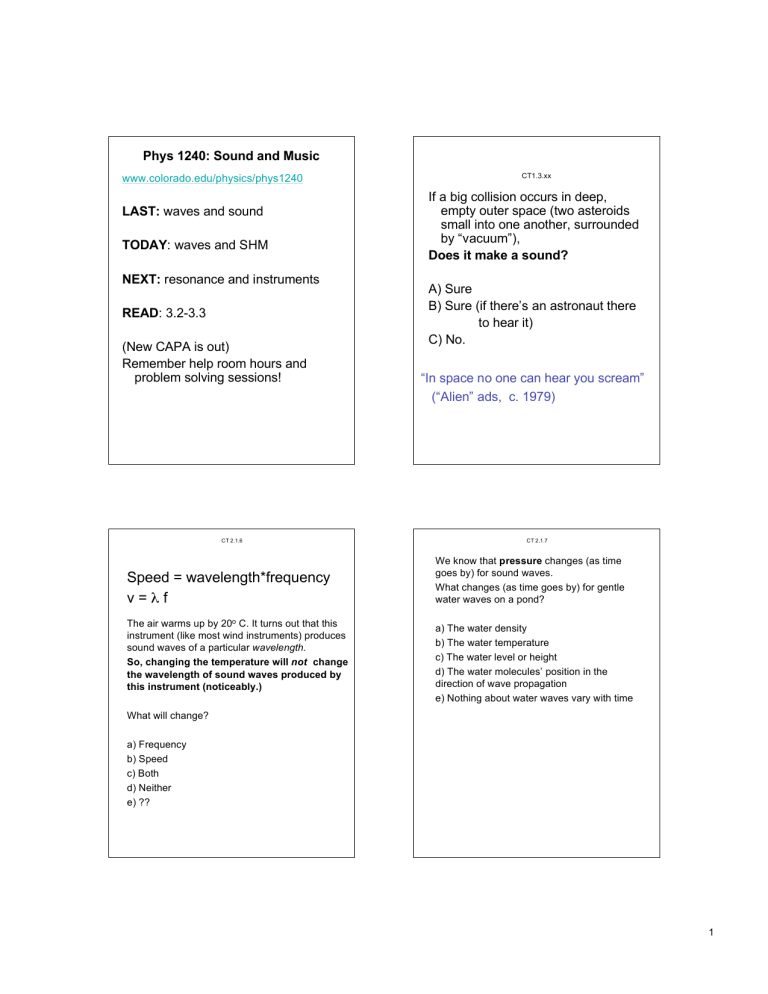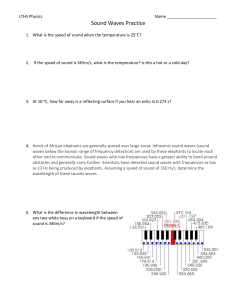Speed = wavelength*frequency v = λ f
advertisement

Phys 1240: Sound and Music www.colorado.edu/physics/phys1240 LAST: waves and sound TODAY: waves and SHM NEXT: resonance and instruments READ: 3.2-3.3 (New CAPA is out) Remember help room hours and problem solving sessions! CT 2.1.6 Speed = wavelength*frequency v=λf The air warms up by 20o C. It turns out that this instrument (like most wind instruments) produces sound waves of a particular wavelength. So, changing the temperature will not change the wavelength of sound waves produced by this instrument (noticeably.) CT1.3.xx If a big collision occurs in deep, empty outer space (two asteroids small into one another, surrounded by “vacuum”), Does it make a sound? A) Sure B) Sure (if there’s an astronaut there to hear it) C) No. “In space no one can hear you scream” (“Alien” ads, c. 1979) CT 2.1.7 We know that pressure changes (as time goes by) for sound waves. What changes (as time goes by) for gentle water waves on a pond? a) The water density b) The water temperature c) The water level or height d) The water molecules’ position in the direction of wave propagation e) Nothing about water waves vary with time What will change? a) Frequency b) Speed c) Both d) Neither e) ?? 1 CT 2.1.8 CT 2.1.9 Looking at the following waveform, what is the period? Looking at that same wave (shown again below), what is its speed? Amplitude Amplitude 1 2 time (sec) 1 a) b) c) d) e) a) 1 sec b) 2 sec c) 1 m/s d) 2 m/s e)Not enough information Time (sec) 1/2 m/s 2 m/s 5 m/s 20 m/s Not enough information Now given that λ=10 m what is the speed of the wave? CT 2.1.10 CT 2.2.1 The wavelength, λ, is 10 m. What is the speed of this wave? Amplitude Time (sec) 1 a) b) c) d) e) 2 An oscilloscope presents a graphical representation of: a) b) c) d) e) Amplitude vs. Position Wavelength vs. Time Voltage vs. Position Voltage vs. Time Wavelength vs Amplitude 1 m/s 7 m/s 10 m/s 15 m/s None of the above/not enough info? 2 CT 2.2.3 CT 2.2.4 What is the period of this wave? What is the period? Amp Amp t=0 t1 t2 0 time time t1 a) b) c) d) e) t1 t2 Not at all defined Not well defined, but t1 is the best answer Not well defined, but t2 is the best answer Simple harmonic motion a) b) c) d) e) t2 t3 t1 t2 t2-t1 t3-t1 None of the above Simple harmonic motion “Harmonic” motion: periodic “Harmonic” motion: periodic If the force pulling you back doubles when you stretch twice as far If the force pulling you back grows linearly with how far from equilibrium you are => SIMPLE harmonic motion displacement time 3 CT 2.4.1 springs Which of the following is necessary to make an object oscillate? i. A stable equilibrium ii. Little or no friction iii. A disturbance a) b) c) d) e) i. only ii. Only iii. Only i and iii only all three Mass on an (ideal) spring is “SHM” (simple harmonic…) The frequency is completely determined** by the •Mass (m) •Spring stiffness (K) (bigger K means more stiff) ** the Amplitude does not matter!! Given the above, will the motion be “Simple Harmonic Motion”? CT 2.4.5 Freq. = (constant) * √ ( K/m) Freq. = (constant) * √ ( K/m) Does this make sense? What if mass is greater? … spring is floppier? (smaller K) A mass on a spring oscillates with a certain amplitude and a certain frequency. If the mass is replaced with one 4 times heavier, what happens to the frequency… A doubles B: increases by 4 C: halves. D: decreases by 4 E: None of these/not sure What happens to the period? 4








